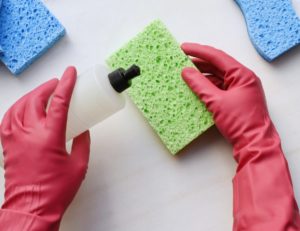Tag: House cleaning tips
How to clean a sponge so that it is free from germs and viruses

Janilyn Hutchings, a certified professional in food safety and a food scientist for StateFoodSafety, says about sponges: “If they’re dirty, they can spread germs to everything they touch, from dishes and utensils to the kitchen counter and appliances.”
Why you should clean a sponge regularly
Yeast, mold, bacteria: All sorts of germs can make your sponges smelly, or worse.
A 2017 study found that fecal coliform bacteria lurks in 44 percent of kitchens, often in sponges and dishcloths. This E. Coli bacteria can be harmless, but certain strains may cause diarrhea, cramps and vomiting. In fact, a study conducted in Japan found that kitchen sponges were second only to drain traps when it came to the highest levels of bacterial contamination in the house.
Your sponge might also harbor other types of bacteria like Staphylococcus aureus or Campylobacter, which can also cause diarrhea. You’re probably more than ready to clean that sponge now, right? Jennifer Quinlan, PhD, professor in Drexel University’s Department of Nutrition Sciences, says don’t wait.
“The general recommendation is to just do it daily,” Quinlan says.
Methods of cleaning sponges
The USDA’s ARS Food Technology and Safety Laboratory has found that two methods work to disinfect a kitchen sponge and make it safe to use again:
Dishwasher: If you run the dishwasher every night before you head off to bed, Quinlan suggests just tossing the kitchen sponge on the top shelf and turning on the dishwasher. The heat disinfects the sponge and your dishes at the same time.
Microwave: “You basically dampen it, you make sure it’s wet, put it in the microwave and you microwave it for a minute,” says Quinlan. “You’ll see steam coming off of it.” Again, the heat is the hero here. But this method isn’t foolproof, so check out this article on how to do it properly.
According to the USDA, these two methods are 99 percent effective in killing off bacteria present in sponges. “It’s really that simple,” says Quinlan.
The following are methods not recommended:
Hot soapy water: Hot tap water won’t be hot enough to get rid of the germs, according to Quinlan. You could boil water on the stove and soak your sponge in that, but only if you don’t have a microwave or dishwasher.
Bleach bath: Heat is more effective than bleach for this purpose, according to Quinlan. “It’s the heat that kills the pathogens,” says Quinlan. Plus, if you try to bleach your sponges, the bleach doesn’t always work its way through the entire sponge. And you risk leaving bleach behind and potentially getting onto food prep surfaces and food.
When to throw your sponge out
At some point, you should just throw the sponge away. Two weeks is a pretty good lifespan for a typical kitchen sponge, says Hutchings.
“Replacing it at least every two weeks will keep the bacteria from spreading and growing, making you sick if you use it,” she says. “You should also replace them if they smell funny and you can’t get rid of the odor, or if they start breaking apart.”
A 2017 study suggests that cleaning your kitchen sponges doesn’t really kill the bacteria as well as you’d think anyway. You might just be better off replacing your sponges each week than trying to clean them.
Via: https://lovelyti.com/?


